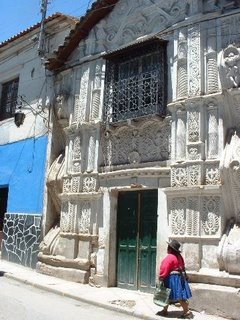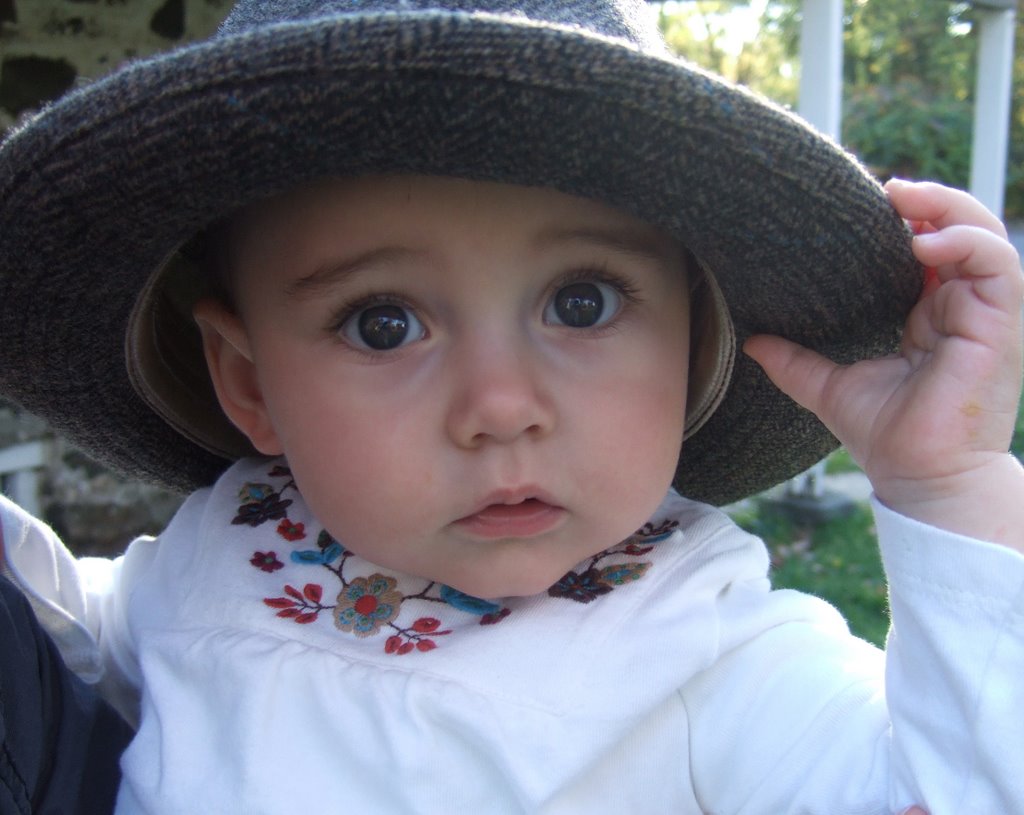Potosi and Sucre

Buen dia!
On the gringo trail, and strangely lovin' it!
Potosi and Sucre are two of the most popular colonial towns to visit in the central highlands of Bolivia. There are a string of tourists tracking through these two cultural gems, and we keep running into the same travelers every other day. For the first time, there is no shortage of english speakers, and our social life has definitely improved. It makes for an entirely different kind of traveling.
Starting with Potosi... what a history! In the last email, I mentioned that Potosi is the highest city in the world at 4090 meters (over 16000 feet above sea level). We were definitely feeling the effects of this high altitude when we arrived by bus. I felt strangely dizzy as I whipped my backpack onto my back, and a little wheezy with each uphill step. Its' claim to fame does not stop with its' height. Back in the 18th century, it also used to be the largest and richest city in Latin America, due to its enormous wealth of silver. UNESCO recognized Potosi as a world heritage site in 1987, and there have been efforts to preserve the grand colonial architecture. You cannot understand Potosi without knowing the life and history of the silver mines. When the Spaniards learned how mineral rich the nearby Cerro Rico mountain was, they began intense excavation on April 1(0?), 1545. It is believed that by 1825 enough silver had been mined to build a bridge to Spain. During this period, in which the Spaniards grew rich, the indigenous indians and black slaves lived painful, tragic lives, bearing the brunt of hard labor. The worst law, La Mita, was established in 1572, and decreed that all adult Indians and black slaves must work daily 12 hour shifts in the mines for a period of 4 months without seeing daylight. At least 8 million miners died from these incredibly dangerous and appalling conditions, which included cave-ins, mercury and silicosis poisoning.
Dan and I took a claustrophobia-challenging tour of some of the present day working mines. Although much silver is still believed to be hidden in the mountain, silver prices are low and it is not easily found. Therefore, Bolivian miners now primarily excavate for lead, zinc, copper, and tin (which has also seen a worldwide drop in value). Most miners join cooperative groups where they share the profits of oreing for these minerals, and are still leading an incredibly dangerous and unhealthy existence within the mines. Retirement with benefits is not a possibility until at least 50% of their lungs show silicosis poisoning, and early death is inevitable.
Dressed in protective plastic suits, wellys, and helmets with flashlights, we entered into the dark, tight, wet, humid Candelabria mines. We visited 3 levels of the mountain, which required crawling on all fours, sliding down steep sides, and climbing rickety ladders through horizontal tunnels. We had been forewarned about cave-ins, made to sign a waiver of responsibility before entering, but had not been prepared for the natural asbestos and arsenic exposure (loose dust that entered through our nose and mouth along with who knows what other carcinogens). The men in the mines chew copious amounts of coca, which we copied. It helps to stave off hunger, as well as relax your breathing and mental state, so that you don't freak out as you gulp for an adequate oxygen supply and sweat profusely with the heat. Before entering the mines, we were taken to some local miner shops where we purchased gifts for the miners. These included coca leaves, soda, and the highly desired dynamite! No joke, we had dynamite sticks, fuses, ammonia nitrate, - all the necessary ingredients (called a completo) for a mighty explosion. There is nothing that will make you appreciate your desk job more, than 3 hours exposure to the life of a miner. Our guides finished the brutal tour with a show of dynamite. They blew-up one completo, outside on a hillside, at a fair distance, so that we could hear the thunder and see the power in one of these monster sticks.
We continued our history lesson, by visiting the Casa Real de la Moneda, originally the place where silver coins were first minted in Potosi. We learned how mercury was used to extract silver from the mined mineral rocks, then mixed with a small amount of copper, before being melted into blocks which could be shipped to Spain or molded into various tools, dishware, coins, etc. Among mining devices and ancient coins, the museum also displayed religious paintings, gold-leafed altars, and archeological finds, like mummies and pottery.
In Potosi city itself, Dan and I did our usual meandering through narrow, hilly, cobble-stoned streets,feasting on coconut torta, llama, and rich veggie soups, visiting craft shops, museums, churches and convents for spectacular views of the city. We watched a religious procession to the main cathedral, - a march of several students, military bands, matronly women with white hankerchiefs, and a large group of suited men, whose responsibility was to carry an enormous statue of the Virgin Mary on a detailed, HEAVY silver pedestal.
------------------------
On to Sucre where the real partying began...
This small, rolling town is considered one of the most beautiful in Bolivia, and at this point, I would definitely have to agree. The city center is a grid work of streets lined with white colonial buildings, wooden, carved balconies, angel reliefs, and the most beautiful central plaza of flowers, mowed lawn, park benches, poplars, and palm trees. The markets are lively and colorful, with buckets of vivid flowers, lanes of baked and heavily iced cakes, tables spread with rainbow colored vegetables, and fruit salad and blended drink stands with stools for sitting. The Bolivian women add the most color with their technicolor wraparounds for carrying their babies, groceries, or spreading out their wares on.
Here, we had the luck of actually knowing a resident. Dan's friend from San Diego, Koa, is in the Peace Corp. He is stationed in a small campo 7 hours outside of Sucre, but has to come to the city every few weeks to shop, run errands, have meetings, RELAX! We were invited to the 'crashpad', where we met several other volunteers, and got to see how they let it all hang out. These people have a lot of energy and drinking stamina, learned from the chicha and puro partying with the campesinos! (Chicha - maize-based fermented alcoholic beverage / puro - PURE, over 90% alcohol).
Our first day, I was invited to join the girls, Kelly (Koa's girlfriend), Bridget, and Maria Rene for a salon outing. I had my first pedicure in almost a year, then we went to Delicias cafe for some girlie natter over tea, chocolate cake and son-sons (a skewer of yucca and cheese). Koa's brother, Kimo, happened to be visiting at the exact same time, so we had a regular crew of Americans for some good ole' celebrations. On both Thursday, Dia de las Mujeres, and Friday we were given the tour of all the hot drinking and dancing spots of Sucre (Cavendish, Joyride, Nanos and Mito's). The night, or rather day, would start with some beer guzzling, or hot singani drinks of tea, cinnamon, sugar lemon and singani wine, and keep going with a little help from coca chomping and Mentisan(The cure all mint gel similar to Vicks-vapor rub. When strategically placed in one's nostrils it can be used to sooth a headache, relieve dusty bus ride nose burns, or disguise even the best smelling frenchies....dan never leaves home without it!). Koa, Kelly and Guadalupe treated us to several homemade meals, including Sushi with bacon, spicy red ahi soup with chicken, thickened with bread crumbs, and grilled, marinated beef slathered in BBQ sauce. Our forays through the city, we're usually on shopping or drinking quests, such as a hike to an outdoor cafe in the Recoleta, a barrio high on a hill with a spectacular view of the city and some delish' chilled cappucinos. At one point Dan had come down with a little Bolivia belly and Koa fixed him right up with an interesting indigenous liquefied remedy of Papaya seeds. At first, it tasted like a blackpepper shake and almost made Dan vomit, (which he thought might be the intention) but within 24 hours he was ready to rage and not smelling up the house.
We've said goodbye to Koa, Kelly and Kimo, who are heading to Arica, Chile for some surfing, on their own little vacation. Dan was a little jealous, because we are heading east. We have been invited to stay at the crashpad for a few more days, so we are trying to see an archeological and textile museum before leaving, and go on a tour to some preserved dinosaur tracks. We've had our first afternoon alone again, strolling through the beautifully manicured Sucre cemetery (about all you can do on a Sunday), and catching up on email.
Missing you all...
Sarah and Dan
We are presently working on posting the Tupiza to Uyuni photos, but connection is dreadful. Sometimes we spend around 3 hours just trying to download. Hopefully, they will be up and ready by the end of our night, so check out http://www.pbase.com/dgsc/boliv2



0 Comments:
Post a Comment
<< Home